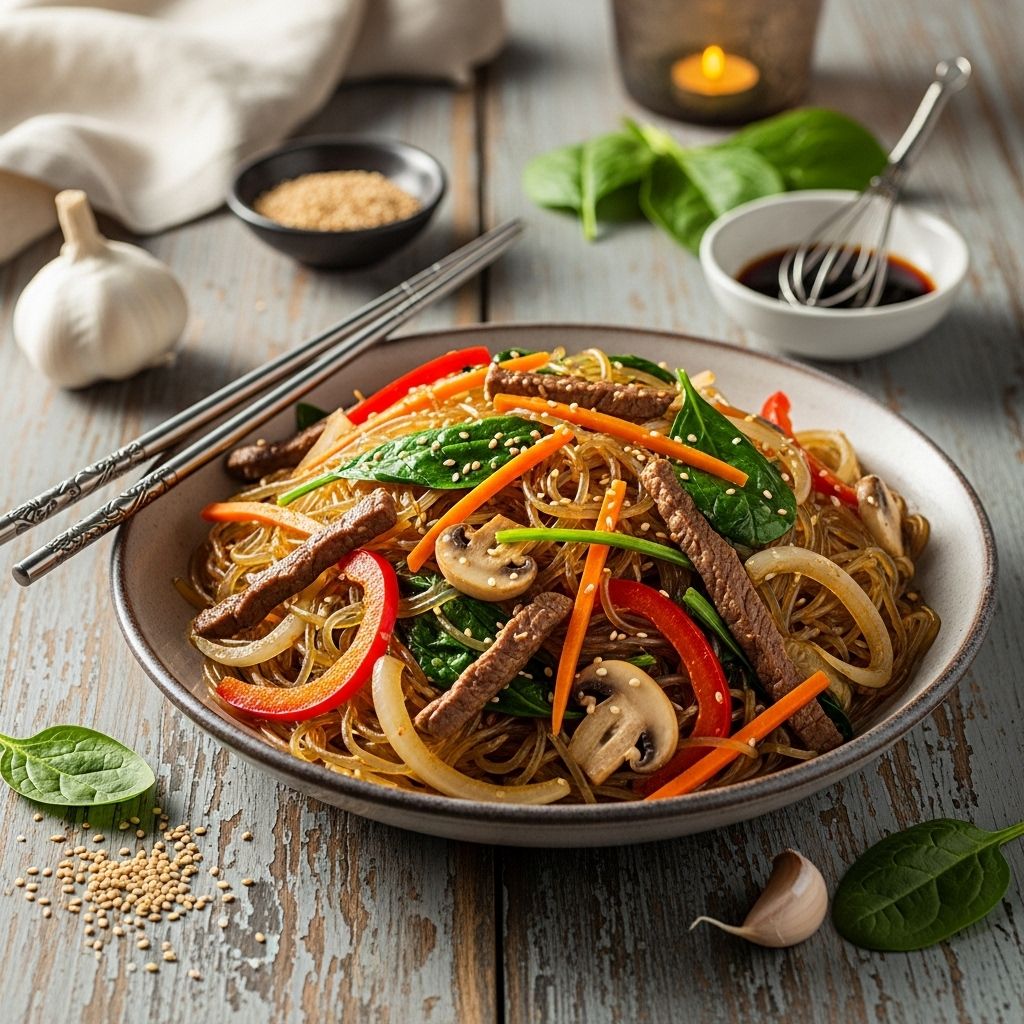Japchae Recipe: 5 Easy Steps For Authentic Korean Glass Noodles
Savor the delightful medley of textures and flavors in this classic Korean japchae recipe, from tips and step-by-step prep to expert FAQs.

Image: HearthJunction Design Team
Yummy Korean Glass Noodles (Japchae)
Korean glass noodles, known as japchae, are a staple in Korean cuisine—famous for their irresistibly chewy texture, glossy appearance, and harmonious blend of sweet and savory flavors. This dish, composed of sweet potato glass noodles stir-fried with an array of colorful vegetables and, optionally, thinly sliced beef or other proteins, is a centerpiece at celebrations and a comforting family favorite. This in-depth guide will walk you through every step of preparing japchae, including ingredient tips, variations, and expert answers to common questions.
What is Japchae?
Japchae is a Korean stir-fry dish that features dangmyeon—translucent, chewy glass noodles made from sweet potato starch—tossed with crisp-tender vegetables, a savory-sweet soy sauce dressing, and typically, strips of beef or sometimes tofu for a vegetarian twist. The name ‘japchae’ translates to ‘mixed vegetables,’ alluding to its origins as a royal vegetarian dish before noodles were introduced. Today, the noodle-based version is the most popular and is often served at parties, holidays, or as a special side or main dish.
Ingredients for Authentic Japchae
Japchae’s beauty lies in its flexibility, but the following are staple ingredients for an authentic flavor and texture:
- Sweet potato glass noodles (dangmyeon)
- Soy sauce (preferably low sodium)
- Brown sugar (or white sugar)
- Sesame oil
- Garlic, minced
- Assorted vegetables, typically:
- Carrots, julienned
- Spinach or similar leafy greens
- Bell peppers (red, yellow, or green)
- Onions
- Mushrooms (shiitake, cremini, or white button)
- Eggs (for garnish, optional)
- Beef (sirloin, rib-eye, or tenderloin, thinly sliced, optional)
- Scallions or green onions
- Sesame seeds for garnish
Typical Japchae Ingredient Table
| Ingredient | Common Amount | Notes |
|---|---|---|
| Sweet potato glass noodles | 8 oz (about 225g) | Main base of the dish |
| Soy sauce | 1/2 cup | For seasoning and marinating |
| Brown sugar | 1/4 cup | Adds sweetness |
| Garlic | 3-4 cloves | Minced |
| Vegetables (mixed) | 2-3 cups | Customize to preference |
| Beef | 4-8 oz | Optional, thinly sliced |
Preparing Japchae: Step-by-Step Instructions
The process for making the perfect japchae involves individual preparation and careful assembly to preserve the vibrant color, texture, and taste of each element.
1. Gather and Prepare Ingredients
- Slice all vegetables into thin, uniform strips. This ensures even cooking and a pleasing presentation.
- Prep the protein: If using beef, slice thinly across the grain. Marinate with 1-2 tablespoons of soy sauce, a dash of sugar, minced garlic, and a splash of sesame oil for at least 10 minutes.
2. Cook the Noodles
- Bring a large pot of water to a rolling boil.
- Add the sweet potato glass noodles and cook for 6-7 minutes until tender but chewy.
- Drain and rinse the noodles in cold water to halt cooking.
- Cut the noodles with kitchen scissors for easier eating (about 6-inch lengths).
- Toss the noodles with a teaspoon or two of sesame oil to prevent sticking.
3. Stir-Fry Vegetables and Protein
- Heat a large skillet or wok over medium-high heat. Add a splash of oil.
- Stir-fry the beef (if using) until just cooked. Remove and set aside.
- One type at a time, stir-fry vegetables in the order of firmness: carrots, onions, bell peppers, and mushrooms. Spinach is typically blanched briefly, then squeezed to remove excess water.
- Set all cooked vegetables and beef aside in a large mixing bowl.
4. Season and Combine
- Add the drained noodles to the mixing bowl with the beef and vegetables.
- Pour in the combined sauce (soy sauce, sugar, garlic, and sesame oil). Toss thoroughly until noodles and vegetables are evenly coated and glossy.
- Adjust seasoning to taste, adding soy sauce or sugar as desired.
5. Garnish and Serve
- Top with sesame seeds and thin egg strips (optional—make a thin omelet, slice, and use as garnish).
- Serve warm, at room temperature, or slightly chilled. Enjoy japchae as a meal or as a show-stopping side dish.
Tips and Techniques for the Best Japchae
- Separate Stir-Frying: Cooking vegetables and proteins separately prevents overcooking and preserves the color and crunch of each component.
- Balancing Flavors: Japchae should taste slightly sweet and savory. Adjust the ratio of soy sauce to sugar to suit your preference.
- Noodle Texture: Don’t overcook the noodles; they should have a pleasant chew.
- Prevent Sticking: Toss the noodles in sesame oil immediately after boiling.
- Vegan or Vegetarian Variation: Omit beef and add more mushrooms or tofu for a satisfying meatless version.
- Make Ahead: Japchae can be served warm or cold and keeps well in the refrigerator for several days.
Serving Ideas and Variations
- Side Dish (banchan): Serve in small portions alongside other Korean favorites like bulgogi or kimchi.
- Main Dish: Increase the protein and vegetables for a hearty one-bowl meal.
- Party Platter: Present japchae on a large platter garnished with extra sesame seeds, egg strips, and scallions for festive gatherings.
- Vegetable Choices: Feel free to add or substitute other vegetables, such as zucchini, snow peas, or asparagus, for a seasonal twist.
Storing and Reheating Japchae
Japchae is delicious both hot and cold. Store leftovers in an airtight container in the refrigerator for up to 3-4 days. To reheat, sprinkle a little water over the noodles and microwave gently, or stir-fry in a pan over low heat to avoid drying out.
Nutrition Information
The nutritional content of japchae varies depending on the exact ingredients and amounts used. On average, a serving contains:
- Calories: Around 250-400 per serving (mainly from noodles and vegetables)
- Protein: Higher if beef or tofu is added
- Carbohydrates: Moderate, mostly from glass noodles and vegetables
- Fat: Low to moderate, depending on added oil and protein
- Vitamins & Minerals: High in vitamin A, C, fiber, and minerals from vegetables
History and Cultural Significance
Japchae originated as a royal dish during the Joseon dynasty, initially made without noodles and comprised purely of stir-fried vegetables. The addition of sweet potato noodles transformed japchae into the crowd-pleasing favorite it is today, enjoyed during holidays such as Korean New Year (Seollal) and Harvest Festival (Chuseok). Traditionally, japchae is a symbol of celebration and hospitality, valued for its vibrant color and balanced flavors.
Frequently Asked Questions (FAQs)
Q: Can I make japchae gluten-free?
A: Yes. Sweet potato noodles are naturally gluten-free, but be sure to use gluten-free soy sauce or tamari when preparing the sauce.
Q: What protein can I use instead of beef?
A: Tofu, chicken, or even seafood such as shrimp are great substitutes. For a vegan option, mushrooms alone add a delicious meaty texture.
Q: Can I prepare japchae ahead?
A: Absolutely! Japchae tastes great even after being chilled and holds up well in the refrigerator, making it perfect for parties or meal prep.
Q: My noodles are sticking together. How do I fix this?
A: Toss the drained noodles immediately with sesame oil after boiling. If they still stick, gently separate them with wet fingers before mixing with sauce and vegetables.
Q: Can I freeze japchae?
A: Freezing is not recommended, as the texture of glass noodles can become mushy when thawed.
Q: Is japchae spicy?
A: No, classic japchae is not spicy. If desired, add a pinch of red pepper flakes or sliced chili for heat.
Japchae vs. Other Korean Noodle Dishes
| Dish | Key Ingredient | Main Flavor | Serving Style |
|---|---|---|---|
| Japchae | Sweet potato glass noodles | Sweet-Savory, Sesame | Warm, room temp, cold |
| Jajangmyeon | Wheat noodles | Black bean sauce | Hot |
| Bibim Guksu | Thin wheat noodles | Spicy, tangy | Cold |
Final Thoughts
Japchae is a universally loved gem in Korean cuisine, celebrated for its texture, color, and harmonious interplay of flavors. Whether served as a festive platter or a weekday comfort dish, mastering japchae brings a taste of Korea’s vibrant food culture into your kitchen. Remember to savor the process—carefully preparing and combining each ingredient results in the signature layered flavors that make japchae so special. Happy cooking!
References
- https://www.allrecipes.com/recipe/236174/japchae/
- https://www.allrecipes.com/recipe/158891/yummy-korean-glass-noodles-jap-chae/
- https://www.allrecipes.com/recipe/196879/jap-chae-korean-glass-noodles/
- https://www.allrecipes.com/recipe/270640/korean-glass-noodles-jap-chae/
- https://mykoreankitchen.com/korean-glass-noodle-stir-fry-japchae/
Read full bio of Srija Burman












